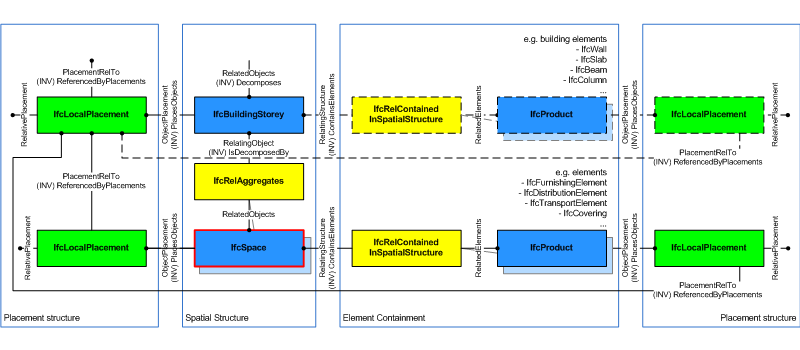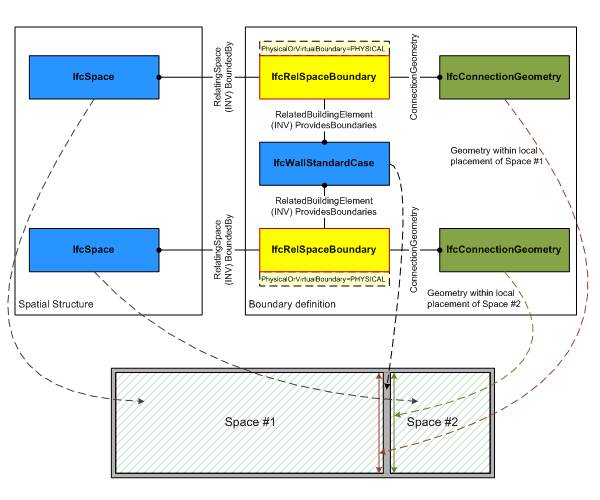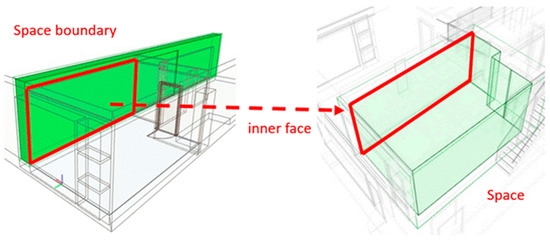More on Ifc Spaces, Zones, Spatial Zone and Spatial Units
Introduction
Spaces in the Spatial Structure of a construction
As documented in The official 4.3.2.0 documentation for "IFC 4.3"., a space represents an area or volume bounded actually or theoretically. Spaces are areas or volumes that provide for certain functions within a building.
A space is associated to a building storey (or in case of exterior spaces to a site). A space may span over several connected spaces. Therefore a space group provides for a collection of spaces included in a storey. A space can also be decomposed in parts, where each part defines a partial space. This is defined by the CompositionType attribute of the supertype IfcSpatialStructureElement which is interpreted as follow:
- COMPLEX = space group
- ELEMENT = space
- PARTIAL = partial space
In a building, a space will typically correspond to one of:
- a room (living room, kitchen, corridor, bathroom, ...)
- an office space
- a commercial surface
- a workshop
- a parking
Space Boundaries
A space is delimited by physical or virtual boundaries.
As documented in The official 4.3.2.0 documentation for "IFC 4.3"., space boundaries are always defined as seen from the space. In general two basic types of space boundaries are distinguished:
- 1st level space boundary: defined as boundaries of the space, not taking into account any change in building element or spaces on the other side.
- 2nd level space boundary: defined as boundary taking any change in building element or spaces on the other side into account. It can be further distinguished into
- 2nd level type A: There is a space on the other side.
- 2nd level type B: There is a building element on the other side.
The exact definition of how space boundaries are broken down depends on the view definition, more detailed conventions on how space boundaries are decomposed can only be given at the domain or application type level.
In an architectural or FM related view, a space boundary is defined totally from inside the space. This is a 1st level space boundary.
In a thermal view, the decomposition of the space boundary depends on the material of the providing building element and the adjacent spaces behind. This is a 2nd level space boundary.
With the space boundary comes the connection geometry as illustrated by the figure below from the paper The Extension of IFC For Supporting 3D Cadastre LADM Geometry.
What this figure illustrates is that although the entire wall is referenced by the space boundary (via the IfcRelSpaceBoundary relationship between the space and the wall), there is also a connection geometry that clearly delineates the boundary of the space with respect to the wall. The precise geometry is necessary for a 3D cadastre, and the surface can be used for the thermal analysis together with the properties of the wall and coverings.
Zones
As documented in The official 4.3.2.0 documentation for "IFC 4.3".
A zone is a group of spaces, partial spaces or other zones. These spaces may or may not be adjacent. A zone does not have its own shape representation.
Zone structures may not be hierarchical, i.e. one individual IfcSpace may be associated with zero, one, or several IfcZone's. IfcSpace's are grouped into an IfcZone by using the objectified relationship IfcRelAssignsToGroup. For example, a zone might be used to represent an apartment as a group of spaces. Although the concept of Spatial Zone appears to to have more capabilities to support adminitrative processes, the IfcZone is also often considered in administrative processes as in BIM/IFC-based 3D spatial model for condominium ownership: A case study of China
Spatial Zones
The Spatial Zone is a relatively recent addition to IFC.
As documented in The official 4.3.2.0 documentation for "IFC 4.3". a spatial zone is a non-hierarchical and potentially overlapping decomposition of the project under some functional consideration.
A spatial zone might have its independent placement and shape representation.
A spatial zone might be used to represent
- a thermal zone
- a construction zone
- a lighting zone
- a security zone
- a usable area zone.
Hence functional perspective(s) also accounted for in the defined PropertySets listed hereunder and documented in The official 4.3.2.0 documentation for "IFC 4.3".
- Pset_AirSideSystemInformation
- Pset_Risk
- Pset_SpaceAirHandlingDimensioning
- Pset_SpaceCommon
- Pset_SpaceCoveringRequirements
- Pset_SpaceFireSafetyRequirements
- Pset_SpaceHVACDesign
- Pset_SpaceLightingDesign
- Pset_SpaceOccupancyRequirements
- Pset_SpaceThermalLoad
- Pset_SpaceThermalLoadPHistory
- Pset_SpaceThermalPHistory
- Pset_SpatialZoneCommon
- Pset_ThermalLoad
- Pset_Tolerance
- Pset_Uncertainty
- Qto_BodyGeometryValidation
- Qto_SpatialZoneBaseQuantities
Link to Spatial Units
The Spatial Zone has AEC Uses Cases as illustrated in IFC Spatial Zone Requirements and Implementation.
But it also appears to be a perfect candidate to provide the bridge between IFC and the Spatial Unit of LADM and related administrative domains of registering Rights, Responsibilities and Restrictions related to building or infrastructures. A number of examples are provided in BIM-Enabled 3D Digital Urban Land Administration
Typically, the IfcSpatialZone will will be anchored to a root element (projet, site, building, storey, or infrastructure) with an ifcRelAggregates relationship, and collect all relevant items present in the IFC via one or more IfcRelReferencedInSpatialStruture relationships.
Adding Spatial Zones to the IFC's
The Spatial Zones (IfcSpatialZone) are a recent addition to the IFC specification. There are therefore not present in most IFC files.
We propose to follow the specification of IFC 4 and relate the IfcSpatialZone to the other elements via the IfcRelReferencedInSpatialStructure relationship.
As an example, we start by relating the IfcSpatialZone with the spaces. In this way, the IfcSpatialZone relates to composing IfcSpaces which in turn embark standard products such as IfcWall, IfcSlab, IfcDoor, IfcWindow, ... via the IfcRelSpaceBoundary relationship.
erDiagram
space
spatialZone ["spatialZone (spatialUnit) : common part, parking, private apartment, office, shop, ..."]
container ["building or storey"]
object["wall, slab, door, window,..."]
propertySet ["functional propertySets"]
container ||--o{ spatialZone : "aggregates (IfcRelAggregates)"
container ||--o{ space : "aggregates (IfcRelAggregates)"
spatialZone ||--|{ space : "referenced in spatial structure (IfcRelReferencedInSpatialStructure)"
container ||--|{ object : "contained in spatial structure (IfcRelContainedInSpatialStructure)"
space }|--|{ object : "bounded by (IfcRelSpaceBoundary)"
propertySet }|--|{ object : "applies to"
propertySet }|--|{ space : "applies to"
propertySet }|--|{ spatialZone : "applies to"
This is one 'recipe' for a Spatial Zone. There may be many others 'recipes' depending on the needs: collect all technical data in a Spatial Zone that shadows the Spatial Unit linked to a BAUnit (Basic Administrative Unit) and provide all the tehnical data that is needed for the administrative process at hand.
All these technical data can be conveyed by ad hoc propertySets. So that they will be available for display when selecting the corresponding element in an IFC Viewer.
IfcSpatialZone for Private Part(s) and Common Part(s)
Within buildings with appartments or mixed occupancy types, there is typically two types of Spatial Zones:
- Private parts: mostly on a storey, but possibly spanning storeys
- Common parts: mostly distributed across storeys
A SpatialZone for Private part(s) will
- relate to one Storey via an IfcRelAggregates relationship: by convention, the storey is that of the main entrance
- relate to all other storeys they are spanning via an IfcRelReferencedInSpatialStructure
A SpatialZone for Common parts will
- relate to the Building via an IfcRelAggregates relationship
- related to all other storeys via an IfcRelReferencedInSpatialStructure


